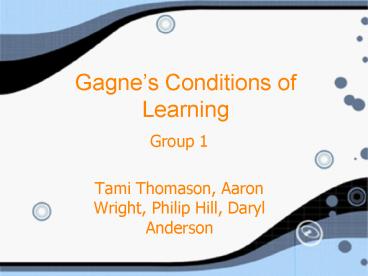Gagnes Conditions of Learning PowerPoint PPT Presentation
1 / 34
Title: Gagnes Conditions of Learning
1
Gagnes Conditions of Learning
- Group 1
- Tami Thomason, Aaron Wright, Philip Hill, Daryl
Anderson
2
Robert Gagne
- An experimental psychologist that focuses on the
learning and instruction processes. - Work consists of how learning and memory are
related. - While in the Air Force, he began developing the
theory he is know so well for today, the
conditions of learning.
3
Learning Outcomes
- Gagne developed a theory that consists of 5
learning outcomes. He classified these
outcomes as outcomes a teacher hopes their
students achieve. - Consist of Verbal information, intellectual
skills, cognitive strategies, attitudes, and
motor skills.
4
5 Learning Outcomes
- Verbal Information-information is stated.
- This does not show that students can understand
the information. - Examples listing steps, reciting poetry.
5
Intellectual Skills
- The ability to perform tasks that require
cognitive activity - Consists of 5 subcategories
- Discriminations
- Concrete concepts
- Defined concepts
- Rules
- Problem Solving
6
Discriminations
- Gagne believes the first level of intellectual
skills is learning to discriminate between things
that are different. - Example
- which symbol is different?
- This kind of activity is called discriminating
7
Concrete Concepts
- Concrete classifying which things belong
together out of a group. - Example
- Put the rectangles in one group and the
ovals in another. - These activities consist of picking out something
that belongs in a group with the others.
8
Defined Concepts
- Classifying abstract ideas that are defined by
the relationship among two or more concepts. - Example Pick out all the nouns in this
paragraph. - My dog and I went to the pet store. My dog
played with the other dogs and then he got a
bone. I bought him a new ball so we could play
at the park. My dog likes to play fetch with a
ball. Hes very smart.
9
Rules
- Being able to carry out an action given some
basic information about how to do it. - Examples
- Mathematics
- Finding averages
10
Problem Solving
- Generating solutions to problems given
appropriate information.
11
Cognitive Strategies
- The process used to reach a particular goal.
- Examples
- Learning new information
- Solving problems that do not have easy solutions
- Test taking strategies
12
Motor Skills
- The ability to use muscles to perform given
tasks. - These muscular movements can vary in their
smoothness and accuracy - In children, this can include cursive writing
- In adults, this can include the ability to drive
a car or control breathing during exercise
13
Attitudes
- Our internal state that influences how we react
in situations - Shows in our tendencies to attack or avoid
certain circumstances - Otherwise known as our personal preferences
- Examples
- Choosing cats over dogs
- Preferring to read Harry Potter rather than do
homework
14
Intellectual Skills Hierarchy
- The hierarchy defines what skills are to be
learned, according to complexity, and also the
sequence of instruction - Each skill is a prerequisite for the others to
happen. One step can not be executed until the
step before it is completed
15
Intellectual Skills Hierarchy (Flow Chart)
16
Gagnes Events of Instruction
- 1. Gaining Attention
- 2. Inform learner of objective
- 3. Stimulate prerequisite learning
- 4. Present new material
- 5. Learning guidance
- 6. Eliciting performance
- 7. Provide feedback
- 8. Assessment of feedback
- 9. Enhance retention and transfer
17
1. Gain Attention
18
2. Identify Objective
- Pose a question, for example
- What is an equilateral triangle?
19
3. Recall Prior Learning
- Definitions of triangles
- 3 sided polygon. Sum of all angles equals 180
degrees. - Equilateral- All 3 sides and angles are equal.
(60 degrees) - Isosceles- 2 sides are of equal length.
- Scalene- Having all 3 sides of different lengths.
- Acute- Having 3 angles of less than 90 degrees
each. - Obtuse- Having one angle greater than 90 degrees.
- Right Triangle- Having one angle of 90 degrees.
20
4. Present Stimulus
60 degrees
- All three sides of an Equilateral Triangle are of
equal lengths and all of the interior angles are
60 degrees.
21
5. Guide Learning
- Create an equilateral triangle by simply drawing
a straight line of the desired length. Then use
a protractor and measure a 60 degree angle from
each end. Connect the dots and Voila!
22
6. Elicit Performance
- Everyone should create 5 different examples of
triangles, at least 3 of these being equilaterals.
23
7. Provide Feedback
- We will now check each triangle and provide
feedback in the form of checking each one as
correct or incorrect.
24
8. Assess performance
- According to the percentage of correct and
incorrect responses, each student will be given a
grade.
25
9. Enhance Retention/Transfer
26
TEST TIME
- What have you learned?
27
1. Driving a car around a track would be an
example of what?
- Attitude
- Motor Skill
- Concept
- Cognitive Strategy
28
2. Students can identify pigeons from a group of
birds.
- Concept
- Rule
- Attitude
- Discrimination
29
3. When shown two dimes and a nickel, the
student will be able to tell which is different.
- Concept
- Rule
- Motor skill
- Discrimination
30
4. Presenting a stimulus is an example of which
cognitive process?
- Reception
- Reinforcement
- Selective perception
- Generalization
31
5. Stimulating recall of prior information is an
example of retrieval.
- True
- False
32
6. Providing feedback is an example of semantic
encoding.
- True
- False
33
Hooray!
Give yourself a pat on the back!
34
Sorry Charlie!
Better Luck Next Time

